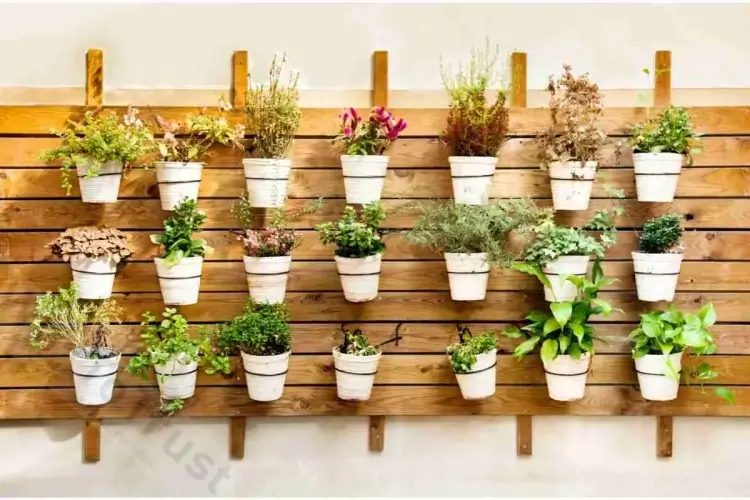Benefits of Indoor herb garden
- Convenience: Having an herb garden means that you have a ready supply of fresh herbs right at your fingertips, which can be very convenient when you’re cooking or need to add some flavor to a dish.
- Health benefits: Many herbs have medicinal properties that can help to improve your health and well-being. For example, basil has been shown to have anti-inflammatory properties, while mint can help to soothe indigestion and calm the stomach.
- Improved air quality: Indoor herb gardens can help to improve the air quality in your home by releasing oxygen and filtering out toxins.
- Aesthetics: An indoor herb garden can be a beautiful and visually appealing addition to your home, adding some greenery and life to your space.
- Relaxation: Taking care of an indoor herb garden can be a relaxing and therapeutic hobby, as it allows you to get in touch with nature and engage in a mindful activity.
- Cost savings: Growing your own herbs can save you money in the long run, as you won’t have to continually purchase fresh herbs from the store.
- Customization: Having an indoor herb garden allows you to choose which herbs you grow, so you can tailor your garden to your specific tastes and needs.
Disadvantages of Indoor herb garden
- Limited space: Indoor herb gardens can take up valuable space in your home, especially if you have a small living space.
- Lighting requirements: Many herbs require a lot of sunlight to thrive, which may be difficult to provide in an indoor setting.
- Pest control: Indoor herb gardens are more susceptible to pests and diseases due to the lack of natural predators. This can be difficult to manage without the use of harsh chemicals.
- Cost: These herb gardens can be expensive to set up, especially if you need to purchase lighting and special equipment.
- Time and effort: Indoor herb gardens require regular care and maintenance, including watering, fertilizing, and pruning. This can be time-consuming and may not be feasible for those with busy schedules.
- Limited variety: These gardens may not be able to accommodate a wide variety of herbs due to space and lighting constraints. This may limit the types of dishes you can prepare with your homegrown herbs.
How to Grow a Indoor Herb Garden?
- Choose the right location for your indoor herb garden with grow light. It should be a spot that gets plenty of sunlight, as most herbs need at least six hours of direct sunlight per day to thrive. If you don’t have a sunny spot in your home, you can use grow lights to provide the necessary light.
- Select the herbs you want to grow. Some popular choices for indoor herb gardens include basil, thyme, rosemary, and chives. Consider the flavors you enjoy and the herbs that are easiest to grow indoors.
- Purchase the necessary pots, soil, and seeds or seedlings. Make sure the pots have drainage holes and are large enough to accommodate the herbs you have chosen. Use a well-draining soil mix specifically formulated for herbs.
- Plant the seeds or seedlings according to the instructions on the seed packet or plant tag. Follow the recommended spacing and water as needed to keep the soil moist but not soggy.
- Place the pots in a sunny location and water regularly to keep the soil moist.
- Fertilize the herbs every few weeks with a liquid or granular fertilizer to promote healthy growth.
- Prune the herbs regularly to encourage new growth and prevent them from becoming overgrown.
- Pest control is important for indoor herb gardens, as pests can quickly spread between plants. If you notice any pests, remove them by hand or use a natural pest control method to keep your herbs healthy.
- Harvest the herbs when they are at their peak and use them in your cooking or drying them for future use.
- Don’t be afraid to experiment with different herbs and combinations to find what works best for your indoor herb garden kit. With a little care and attention, you’ll be able to enjoy fresh herbs all year round.
Do indoor herb gardens really work?
Indoor herb gardens can be a great way to grow fresh herbs for cooking and other uses right in your own home. They can be particularly useful for people who don’t have access to outdoor space for gardening or who live in areas with harsh weather conditions that make it difficult to grow herbs outdoors.
There are several factors that can influence the success of an indoor herb garden with light, including the type of herbs you choose to grow, the amount of sunlight and warmth they receive, and the quality of the soil and watering practices. Some herbs, such as basil and mint, are relatively easy to grow indoors and can thrive in a sunny windowsill or under artificial grow lights. Others, such as rosemary and thyme, may be more challenging to grow indoors and may require more specific care.
Overall, with proper care and attention, indoor herb gardens can be an enjoyable and rewarding hobby. It’s always a good idea to do some research and choose herbs that are well-suited to growing indoors, and to follow best practices for watering, fertilizing, and providing proper lighting to help ensure the success of your indoor herb garden windowsill.
When should you plant an indoor herb garden?
It is best to plant an indoor herb garden in the spring or early summer, when there is plenty of sunlight and the temperature is warm enough for the herbs to thrive. This allows the herbs to establish themselves and grow strong before the colder winter months. It is also important to ensure that the herbs have access to sufficient light and water, as well as proper drainage, to help them grow and flourish.

